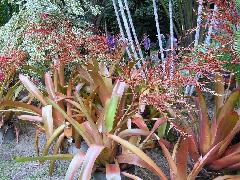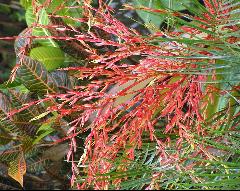Aechmea blanchetiana
Click thumbnails for full size, scaled to a new window.
Aechmea blanchetiana


| Peter Sargent, Mossman. Photo Ken Woods. Grown in full sun. |
Aechmea blanchetiana (Baker) L. B. Smith, Smithson. Misc. Collect. 126: 13, 205. 1955.
Streptocalyx laxiflora Baker, Handb. Bromel. 31. 1889; non Aechmea laxiflora Bentham, 1846. Type. Bahia, Brazil, Blanchet 2274 (BM).
Tillandsia blanchetiana Baker, Handb. Bromel. 182. 1889.
Aechmea laxiflora (Baker) Mez, Martius Fl. Bras. 3(3): 335. 1892; non Bentham, 1846.
Aechmea remotiflora Mez, DC. Monogr. Phan. 9: 219. 1896; nomen novum for Aechmea laxiflora (Baker) Mez.
Desc from S&D
Plant flowering 12-18 dm high.
Leaves about 12 in a dense funnel form rosette , straight or slightly curved, to 9 dm long;
Sheaths broadly ovate, very large, entire, dark brown, covered with minute appressed scales;
Blades ligulate, broadly rounded and apiculate, to 10 cm wide, densely serrate with dark spines 1 mm long, covered with minute pale appressed scales especially beneath.
Scape erect, to 15 mm in diameter;
Scape-bracts imbricate and wholly covering the scape, broadly ovate, subacute, over 8 cm long, deciduous.
Inflorescence laxly tripinnate;
Primary bracts lanceolate, acute, much shorter than the branches;
Branches subspreading; spikes linear, laxly many flowered, 15-35 cm long;
Rhachis nearly straight, slender, compressed, sparsely white flocculose or glabrous.
Floral bracts sub erect or divergent, not covering the rhachis, lance-ovate, acuminate but not pungent, 30-35 mm long, about equaling the sepals and 2-3 times as long as the internodes, convex, coriaceous and red with submembranaceous entire yellow margins, strongly nerved at least by the margins and apex, nearly glabrous;
Flowers sessile, 4 cm long.
Sepals strongly asymmetric, narrowly sublanceolate, acute, to 24 mm long, short-connate, strongly nerved, glabrous;
Petals ligulate, yellow, bearing 2 oblong scales at base;
Stamens included;
Ovary subellipsoid, constricted at apex, trigonous, 15 mm long, epigynous tube large; placentae subapical; ovules caudate.
Type. Blanchet s n (holotype, BM), Bahia, Brazil.
Distribution. Terrestrial in coastal scrub (restinga), Bahia, Brazil.
BRAZIL. Bahia: Agua Preta, 1939, Foster 74 (GH, R, US); Canavieiras, 29 Jan 1965, Lanna 734 & Castellanos 25486 (GUA, US); Itapebi to Belmonte, 13 Apr 1967, Lanna 1318 & Castellanos 26341 (HB, US); Parque Nacional de Monte Pascoal, 26 Mar 1968, Vinha & Santos 165 (US).
From Baker 1889 Protologue
6. STREPTOCALYX LAXIFLORA Baker.
Inflorescence a large lax panicle;
branches lax-flowered, reaching a foot in length, the lower compound;
flower-bracts ascending, oblong, strongly ribbed, an inch long.
Calyx with ovary 1 1/4 in. long;
sepals lanceolate, 2-3 times the length of the ovary, conspicuously mucronate.
Hab. Central Brazil; Bahia, Blanchet 2274 ! (Herb. Mus. Brit).
Protologue
Tillandsia blanchetiana Baker, Handb. Bromel. 182. 1889.
104. TILLANDSIA BLANCHETIANA Baker.
Basal leaves not seen.
Panicle deltoid, a foot or more long;
lower branches with 3-4 branchlets; final spikes dense, 3-4 in. long, 5/8 in. diam.;
flower-bracts ovate, acute, ¾ - 7/8 in. long. Calyx as long as the bract.
Hab. Brazil; Bahia, Blanchet 1 (Herb. Mus- Brit.). Near T. polystachya.
From Mez 1935
37. Ae. remotiflora Mez in DC. Monogr. Phaner. IX. (1896) 219.
Streptocalyx laxiflora Bak. Bromel. (1889) 31.
Aechmea laxiflora Mez (non Benth.) in Mart. Fl. Brasil. III. 3. (1892) 219.
Tillandsia Blanchetiana Bak., l. c. 782.
Folia ignota. Vaginae scapales integerrimae. Inflorescentia perlaxe tripinnatim panniculata e ramis florigeris pedalibus, haud geniculatis, omnibus fertilibus, multifloris, glabris composita; bracteis florigeris ovali-lanceolatis, peracutis, valde venoso-striatis, glabris, integerrimis, margine cum axi haud connatis, flores involventibus eosque aequantibus vel paullo tantum iis brevioribus. Flores sessiles, ad 40 mm longi; sepalis basi minute connatis, ad 21 mm longis, glabris, optime venoso-striatis, perasymmetricis, apice mucronatis. Petala basi ligulata, alte cum filamentis ser. II. connata. Ovarium glabrum, fere 15 mm longum; placentis interno loculorum angulo in ¾ altit. affixis; ovulis longe caudatis.
Brasilien: Staat Bahia, ohne Standortsangabe (Blanchet n.2274).
Updated 15/05/21

